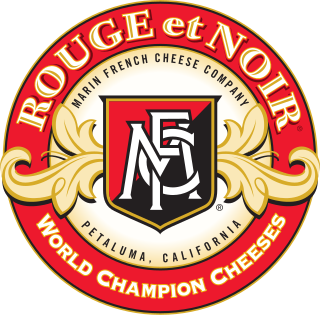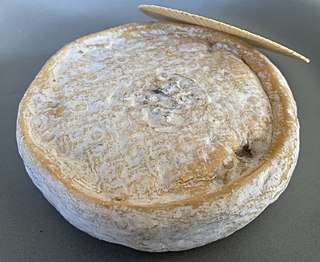
Brie is a soft cow's-milk cheese named after Brie, the French region from which it originated. It is pale in color with a slight grayish tinge under a rind of white mould. The rind is typically eaten, with its flavor depending largely upon the ingredients used and its manufacturing environment. It is similar to Camembert, which is native to a different region of France.

Goat cheese, or chevre, is cheese made from goat's milk. Goat cheese is made in a wide variety of styles, from soft fresh cheese to hard aged cheese.

Camembert is a moist, soft, creamy, surface-ripened cow's milk cheese. It was first made in the late 18th century in Camembert, Normandy, in northwest France. It is sometimes compared in look and taste to brie cheese.

Brie de Meaux is a French brie cheese of the Brie region and a designated AOC product since 1980. Its name comes from the town of Meaux in the Brie region. As of 2003, 6,774 tonnes were produced annually.

Stinking Bishop is a washed-rind cheese produced since 1972 by Charles Martell and Son at Hunts Court Farm, Dymock, Gloucestershire, in the west of England. It is made from the milk of Gloucester cattle.

Fontina is a cow's milk cheese, first produced in Italy. Over time, production of Fontina has spread worldwide, including the United States, Denmark, Sweden, Quebec, France and Argentina.

Grana Padano is a cheese originating in the Po river Valley in northern Italy that is similar to Parmigiano-Reggiano cheese. There are less strict regulations governing its production compared to Parmigiano-Reggiano. This hard, crumbly-textured cheese is made with unpasteurized cows' milk that is semi-skimmed through a natural creaming process. To preserve the authenticity of the manufacturing processes and raw materials used to make this cheese, in the Grana Padano is registered as Geographical Indication in Italy since 1954 and as a European Union protected designation of origin (PDO) since 1996, and is protected in several other countries based on the Lisbon Agreement and bilateral agreements.

Geotrichum candidum is a fungus which is a member of the human microbiome, notably associated with skin, sputum and feces where it occurs in 25–30% of specimens. It is common in soil and has been isolated from soil collected around the world, in all continents.

Types of cheese are grouped or classified according to criteria such as length of fermentation, texture, methods of production, fat content, animal milk, and country or region of origin. The method most commonly and traditionally used is based on moisture content, which is then further narrowed down by fat content and curing or ripening methods. The criteria may either be used singly or in combination, with no single method being universally used.

Beecher's Handmade Cheese is an artisan cheesemaker and retail shop with locations in the Pike Place Market, Seattle, Washington and New York City's Flatiron District. The company was founded by Kurt Beecher Dammeier in 2003 and opened in the Pike Place Market after Dammeier obtained a difficult to obtain storefront lease in the Market. Because Dammeier had never been a cheesemaker, he sought out the assistance of Brad Sinko, who helped run a family cheese-making business in Oregon. A second location was opened in 2011 in the Flatiron neighborhood of Manhattan in New York City.
Artisanal cheese refers to cheeses produced by hand using the traditional craftsmanship of skilled cheesemakers. As a result, the cheeses are often more complex in taste and variety. Many are aged and ripened to achieve certain aesthetics. This contrasts with the more mild flavors of mass-produced cheeses produced in large-scale operations, often shipped and sold right away.

The Marin French Cheese Company is a manufacturer of artisan cheese located in rural west Marin County, California. The company was founded in 1865 by Jefferson Thompson, and produces cheeses under the Marin French Cheese brand name. It is the oldest continually operating cheese manufacturer in the United States.

Chevrotin is a soft goat's milk based cheese produced in the historical region of Savoy, (France). Since 2002 it has enjoyed an AOC designation.

Casín cheese is a Spanish cheese made in the Principality of Asturias. Its name is covered by a protected designation of origin (PDO). It is made from full-fat, unpasteurized cows' milk from specific breeds, namely Asturian Mountain, Asturian Valley (Asturiana de la Valles), Friesian and any crosses between these breeds. Specifically the geographic area of manufacture is the southern part of Asturias which includes the Redes Natural Park and associated land, this is within the municipalities of Caso, Sobrescobio and Piloña. The cheese is classified as hard and semi-hard, and can be semi-cured or cured. It takes its name from one of the breeds of cattle whose milk is used, in turn named after the town of Caso. The shape of the cheese is a thick disc-shape, sometime more conical, of 10–20 cm diameter and 4–7 cm in height. The weight is between 250 and 1,000 g.
Jasper Hill Farm is an artisan cheesemaker in Greensboro, Vermont, owned and operated by Andy and Mateo Kehler. Jasper Hill Farm is also the location of the Cellars at Jasper Hill, which provides aging, sales & marketing services.













